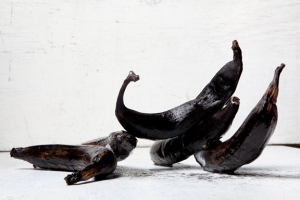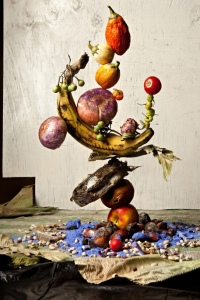At the very beginning of term, we were given our first task which was to take a chosen route from the college making our way to the Photographers Gallery, but of course, it wasn’t that simple. Along the route we were to take photos of the areas we visited and make a small series of work called “The Journey.”
All good fun of course BUT I was worried that by the time I had got to the Gallery that I would struggle to take any notice of any photographers work after concentrating on what photos I could, would and need to take for the Journey, especially as I had done a little research beforehand and immediately thought it really wouldn’t be my cup of tea and how am I supposed to take note of work that really doesn’t jump out at me!
Well my learning lesson for that day was not to jump the gun and presume I don’t like something by only researching on the internet and actually go and see the work in the gallery, because looking at photos available on the web doesn’t give you the same interpretation as actually standing in front of the original work.
I am talking about the artist, Lorenzo Vitturi.
The night before I had read how some considered his work not to be classed as photography, that his work was more about sculpture. I didn’t really want to be in the position where I would need to decide for myself how I felt about his work and I didn’t think for a minute that I would be captivated by an image from the moment I walked through the door.
http://thephotographersgallery.org.uk/dalston-anatomy-2
Below: A Dalston Anatomy-Lorenzo Vitturi This is the image that took my breath away.

I’m not one who enjoys talking, I don’t even look for things to talk about but this image had my inner voice screaming in my ears….everything my eyes were picking up whilst standing there, mesmerized by something so simple, yet so dark. And meaningful, making me look deeper and showing me all these ideas that kept throwing themselves at me, eventually fitting together until I could finally come to the one conclusion.
What do I see? What did I see?
I saw seals, I saw snow, I saw Viking boats, I saw death. I felt compassion, I felt desperation, I felt the chill. I could touch the roughness and seek comfort in the smoothness of silence.
It wasn’t until I got home and scribbled what I saw down onto paper that I realised everything I felt I could see lead to the one word that gave meaning to the feelings above. COLD!
Every time I look at this image I am drawn to the bottom left hand side. That one piece of fruit is able to make me feel an emotion, and as stupid as that may sound to some, to an artist, even if one hundred people feel a hundred different emotions, his job is well done.
All these strange feelings that came from an image of discarded fruit transformed into a surreal sculpture.
So my next question to myself is “Why?” Why am I drawn to this image in such a fanatical way?
Is it because every other image around the room was full of colour? Other images showed brightly coloured decaying fruit and vegetables that had been sculptured appeared warm and unfrightening. Even the portraits of the people were colourful, why wasn’t this one?
I think that I can only now give a possible answer but only because while researching and deciding on a project for another unit, I have come to realise that I am trying to say something with my own photography, I’m trying to give the silent a voice, whether it be personal, fictional or for somebody else.
For me personally, silence should only be for the dead, but for so many of the living, silence is unavoidable and seeking any form of voice can lead to tragic consequences. And because this is how I feel, I am drawn to images that look desperate, in need of warmth, where death is seen as a comfortable solution but the journey there is one of pain, coldness and never ending even though its inevitable.
Who is Lorenzo Viturri?
Viturri is an Italian artist who lives in Dalston, East London.
He focuses on street scenes and portraits of the local people and his latest work, Dalston Anatomy, is about capturing the vibrancy of Ridley Road market before it falls victim to gentrification. He has managed this by sculpturing vegetables both bright and decaying and then taking their portraits.
Viturri was born in Venice and I feel that this is where we can draw comparisons between his life there and his interest in the vibrant market places around Dalston.
He is also very passionate about food and can apparently point you in the right direction anywhere in the world for good eating.
I think “Dalston Academy” gives the viewer an insight into his ideas which show him exploring around creation, consumption and decay. It is certainly as far away as possible from traditional street photography that most of us are used too, but it still manages to capture and express “Meaning.”
Viturri photographed the market and its regulars whilst also buying his materials such as paint, dyes and chalk from the local traders. These were used to creatively deface his images. He also daily would bring home discarded fruit and vegetables which he then transformed by sculpturing them in his nearby studio.
One of Viturri’s fruit and vegetable sculptures.
In an interview with the Guardian, Vitturi said this of his work:
“Every day people are inventing ways to present themselves and their small shops to the passing public,” says Vitturi. “It’s an endlessly creative as well as commercially competitive place that can sometimes be a little overwhelming, but it is that edgy dynamic that I wanted to reflect in my images. I was trying to recreate the identity of the market through whatever I could find there that served my vision of the place and its energy. So the coloured chalk that is used to cover some of the faces in the images is sold in little baskets on a stall on Ridley Road. Later, I found out that the chalk is used as a painkiller in West Africa for women who are pregnant. Every picture has a hidden story.”
Do I still feel a connection with his work and my own ideas about giving the silence a voice after researching and listening to what he has to say? Do I still see that one image in the same way as I firstly did?
Yes. He wanted to recreate an identity for the market for the rest of the world to see that its energy existed before being laid to rest. It doesn’t matter how much colour is available, it eventually fades away just like everything else.
